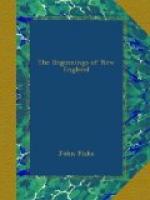During the years immediately following the voyage of the Mayflower, several attempts at settlement were made about the shores of Massachusetts bay. One of the merchant adventurers, Thomas Weston, took it into his head in 1622 to separate from his partners and send out a colony of seventy men on his own account. These men made a settlement at Wessagusset, some twenty-five miles north of Plymouth. They were a disorderly, thriftless rabble, picked up from the London streets, and soon got into trouble with the Indians; after a year they were glad to get back to England as best they could, and in this the Plymouth settlers willingly aided them. In June of that same year 1622 there arrived on the scene a picturesque but ill understood personage, Thomas Morton, “of Clifford’s Inn, Gent.,” as he tells on the title-page of his quaint and delightful book, the “New English Canaan.” Bradford disparagingly says that he “had been a kind of petie-fogger of Furnifell’s Inn”; but the churchman Samuel Maverick declares that he was a “gentleman of good qualitie.” He was an agent of Sir Ferdinando Gorges, and came with some thirty followers to make the beginnings of a royalist and Episcopal settlement in the Massachusetts bay. He was naturally regarded with ill favour by the Pilgrims as well as by the later Puritan settlers, and their accounts of him will probably bear taking with a grain or two of salt. [Sidenote: Wessagusset and Merrymount]
In 1625 there came one Captain Wollaston, with a gang of indented white servants, and established himself on the site of the present town of Quincy. Finding this system of industry ill suited to northern agriculture, he carried most of his men off to Virginia, where he sold them. Morton took possession of the site of the settlement, which he called Merrymount. There, according to Bradford, he set up a “schoole of athisme,” and his men did quaff strong waters and comport themselves “as if they had anew revived and celebrated the feasts of ye Roman Goddes Flora, or the beastly practices of ye madd Bachanalians.” Charges of atheism have been freely hurled about in all ages. In Morton’s case the accusation seems to have been based upon the fact that he used the Book of Common Prayer. His men so far maintained the ancient customs of merry England as to plant a Maypole eighty feet high, about which they frolicked with the redskins, while furthermore they taught them the use of firearms and sold them muskets and rum. This was positively dangerous, and in the summer of 1628 the settlers at Merrymount were dispersed by Miles Standish. Morton was sent to England, but returned the next year, and presently again repaired to Merrymount.
By this time other settlements were dotted about the coast. There were a few scattered cottages or cabins at Nantasket and at the mouth of the Piscataqua, while Samuel Maverick had fortified himself on Noddle’s Island, and William Blackstone already lived upon the Shawmut peninsula, since called Boston. These two gentlemen were no friends to the Puritans; they were churchmen and representatives of Sir Ferdinando Gorges.




